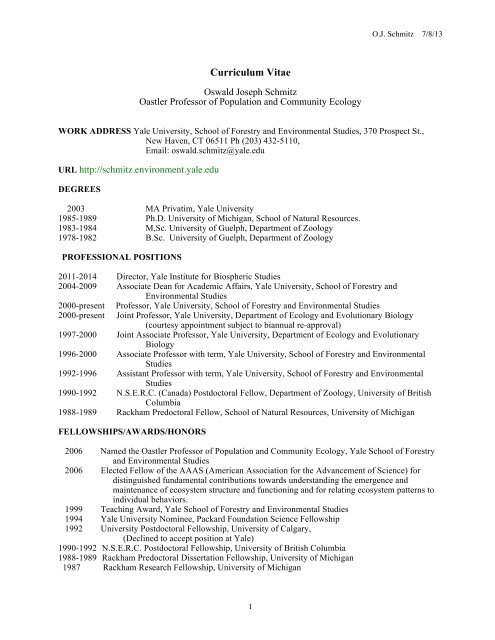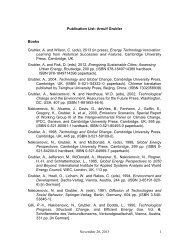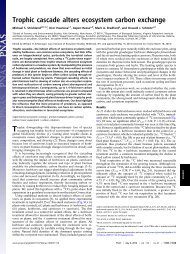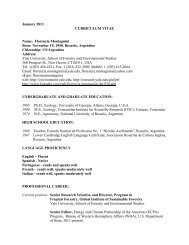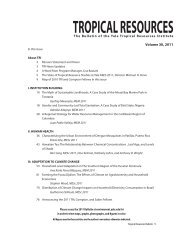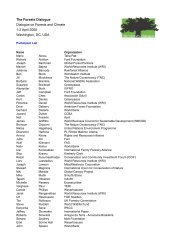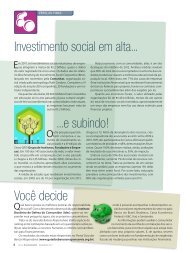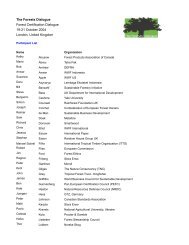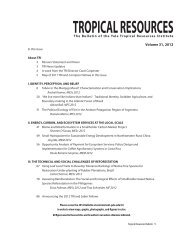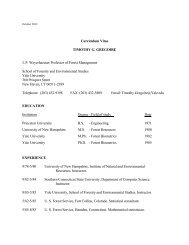CV - Download - Yale School of Forestry & Environmental Studies
CV - Download - Yale School of Forestry & Environmental Studies
CV - Download - Yale School of Forestry & Environmental Studies
Create successful ePaper yourself
Turn your PDF publications into a flip-book with our unique Google optimized e-Paper software.
O.J. Schmitz 7/8/13<br />
Curriculum Vitae<br />
Oswald Joseph Schmitz<br />
Oastler Pr<strong>of</strong>essor <strong>of</strong> Population and Community Ecology<br />
WORK ADDRESS <strong>Yale</strong> University, <strong>School</strong> <strong>of</strong> <strong>Forestry</strong> and <strong>Environmental</strong> <strong>Studies</strong>, 370 Prospect St.,<br />
New Haven, CT 06511 Ph (203) 432-5110,<br />
Email: oswald.schmitz@yale.edu<br />
URL http://schmitz.environment.yale.edu<br />
DEGREES<br />
2003 MA Privatim, <strong>Yale</strong> University<br />
1985-1989 Ph.D. University <strong>of</strong> Michigan, <strong>School</strong> <strong>of</strong> Natural Resources.<br />
1983-1984 M,Sc. University <strong>of</strong> Guelph, Department <strong>of</strong> Zoology<br />
1978-1982 B.Sc. University <strong>of</strong> Guelph, Department <strong>of</strong> Zoology<br />
PROFESSIONAL POSITIONS<br />
2011-2014 Director, <strong>Yale</strong> Institute for Biospheric <strong>Studies</strong><br />
2004-2009 Associate Dean for Academic Affairs, <strong>Yale</strong> University, <strong>School</strong> <strong>of</strong> <strong>Forestry</strong> and<br />
<strong>Environmental</strong> <strong>Studies</strong><br />
2000-present<br />
2000-present<br />
Pr<strong>of</strong>essor, <strong>Yale</strong> University, <strong>School</strong> <strong>of</strong> <strong>Forestry</strong> and <strong>Environmental</strong> <strong>Studies</strong><br />
Joint Pr<strong>of</strong>essor, <strong>Yale</strong> University, Department <strong>of</strong> Ecology and Evolutionary Biology<br />
(courtesy appointment subject to biannual re-approval)<br />
1997-2000 Joint Associate Pr<strong>of</strong>essor, <strong>Yale</strong> University, Department <strong>of</strong> Ecology and Evolutionary<br />
Biology<br />
1996-2000 Associate Pr<strong>of</strong>essor with term, <strong>Yale</strong> University, <strong>School</strong> <strong>of</strong> <strong>Forestry</strong> and <strong>Environmental</strong><br />
<strong>Studies</strong><br />
1992-1996 Assistant Pr<strong>of</strong>essor with term, <strong>Yale</strong> University, <strong>School</strong> <strong>of</strong> <strong>Forestry</strong> and <strong>Environmental</strong><br />
<strong>Studies</strong><br />
1990-1992 N.S.E.R.C. (Canada) Postdoctoral Fellow, Department <strong>of</strong> Zoology, University <strong>of</strong> British<br />
Columbia<br />
1988-1989 Rackham Predoctoral Fellow, <strong>School</strong> <strong>of</strong> Natural Resources, University <strong>of</strong> Michigan<br />
FELLOWSHIPS/AWARDS/HONORS<br />
2006 Named the Oastler Pr<strong>of</strong>essor <strong>of</strong> Population and Community Ecology, <strong>Yale</strong> <strong>School</strong> <strong>of</strong> <strong>Forestry</strong><br />
and <strong>Environmental</strong> <strong>Studies</strong><br />
2006 Elected Fellow <strong>of</strong> the AAAS (American Association for the Advancement <strong>of</strong> Science) for<br />
distinguished fundamental contributions towards understanding the emergence and<br />
maintenance <strong>of</strong> ecosystem structure and functioning and for relating ecosystem patterns to<br />
individual behaviors.<br />
1999 Teaching Award, <strong>Yale</strong> <strong>School</strong> <strong>of</strong> <strong>Forestry</strong> and <strong>Environmental</strong> <strong>Studies</strong><br />
1994 <strong>Yale</strong> University Nominee, Packard Foundation Science Fellowship<br />
1992 University Postdoctoral Fellowship, University <strong>of</strong> Calgary,<br />
(Declined to accept position at <strong>Yale</strong>)<br />
1990-1992 N.S.E.R.C. Postdoctoral Fellowship, University <strong>of</strong> British Columbia<br />
1988-1989 Rackham Predoctoral Dissertation Fellowship, University <strong>of</strong> Michigan<br />
1987 Rackham Research Fellowship, University <strong>of</strong> Michigan<br />
1
O.J. Schmitz 7/8/13<br />
BIOGRAPHICAL SKETCH<br />
Oswald Schmitz is the Oastler Pr<strong>of</strong>essor <strong>of</strong> Population and Community Ecology, in the <strong>Yale</strong><br />
University <strong>School</strong> <strong>of</strong> <strong>Forestry</strong> and <strong>Environmental</strong> <strong>Studies</strong>. He studies the linkage between two<br />
important components <strong>of</strong> natural systems: biodiversity and ecosystem services. These issues are<br />
examined using field experimentation guided by formal mathematical theory <strong>of</strong> species<br />
interactions. Both theory development and field research is aimed at identifying functionally<br />
unique groupings <strong>of</strong> predators and herbivores. These insights are used to explain how predator<br />
and herbivore species determine the species composition and productivity <strong>of</strong> plants in ecosystems,<br />
and ensuing ecosystem processes such as nutrient and carbon cycling. Research also focuses on<br />
elucidating how important environmental disturbances, such as global climate change and natural<br />
resource exploitation, alter the nature and strength <strong>of</strong> species interactions in ecosystems and<br />
ensuing ecosystem services. The scientific insights aid efforts to conserve vital services that<br />
species in ecosystems provide to humankind. His research evaluates how to rethink conservation<br />
strategies by considering species as part <strong>of</strong> a natural portfolio. This portfolio represents a wealth<br />
<strong>of</strong> potential alternatives to contemporary technologically intensive and expensive approaches in<br />
environmental management. His book “Ecology and Ecosystem Conservation” encapsulates<br />
much <strong>of</strong> his thinking about biodiversity and ecosystems and was heavily inspired by the writings<br />
<strong>of</strong> Aldo Leopold. More recently, his book “Resolving Ecosystem Complexity” lays out a<br />
blueprint for conducting empirical research to provide predictive understanding <strong>of</strong> how an<br />
ecosystem’s complexity develops from the vast numbers <strong>of</strong> species interacting within it.<br />
PROFESSIONAL AFFILIATIONS<br />
Ecological Society <strong>of</strong> America; American Association for the Advancement <strong>of</strong> Science; Society <strong>of</strong><br />
American Naturalists, Society for Conservation Biology<br />
PROFESSIONAL SERVICE<br />
To Conservation and Policy<br />
2012 Science Advisor, Open Space Institute’s Northeast Resilient Landscapes Initiative<br />
2005-2009 Advisory Board Member, Center for Conservation Solutions, American Forest<br />
Foundation, Washington, DC.<br />
2004 Member, US <strong>Environmental</strong> Protection Agency (EPA) Scientific Advisory Board ad hoc<br />
panel reviewing the EPA Report on the Environment.<br />
2004 Presented “The effects <strong>of</strong> global climate change on species diversity and ecosystem<br />
functioning within the continental USA” to the spring meeting <strong>of</strong> the New<br />
England Governors and Eastern Canadian Premier’s conference. This was a prelude<br />
to the fall meeting that led to significant New England wide agreements and<br />
subsequent legislation on controlling greenhouse gas emissions in New England.<br />
1994 – 2000 Scientific Advisory Board, Mistik Forest Management Ltd., Saskatchewan, Canada<br />
1999 Member, Scientific Advisory Panel on “Total Land Management”, Mining Prospectors<br />
and Developers Association <strong>of</strong> Canada.<br />
To Academics<br />
2012 Member, Society <strong>of</strong> American Naturalists ad hoc committee to select the Editor-in-Chief<br />
<strong>of</strong> The American Naturalist<br />
2012- Member, Steering Committee, Predator-Prey Gordon Research Conference<br />
2
O.J. Schmitz 7/8/13<br />
2011-2012 Member, Steering Committee for Workshop: Climate change and species interactions:<br />
ways forward. Institute <strong>of</strong> Ecosystem <strong>Studies</strong>, Millbrook NY<br />
2010- Member, Editorial Advisory Board, Encyclopedia <strong>of</strong> Sustainability Volume 5: Ecosystem<br />
Management and Sustainability.<br />
2010 Judge, Blavatnik Awards for Young Scientists, New York Academy <strong>of</strong> Sciences.<br />
2010 Member, Millennium Conferences proposal review committee, Ecological Society <strong>of</strong><br />
America.<br />
2004-2010 Invited Faculty Member, Community Ecology and Biodiversity Group (1 <strong>of</strong> 9 original<br />
Internationally) Faculty <strong>of</strong> 1000 Biology—A next-generation literature awareness tool<br />
in which faculty members highlight the most interesting papers published in the<br />
biological sciences.<br />
2006 Review Panel Member, US National Science Foundation (NSF) Ecological Biology<br />
Program.<br />
2004 External Faculty Opponent, Ph.D. Dissertation, Umeå University<br />
2002 External Faculty Opponent, Ph.D. Dissertation, University <strong>of</strong> Amsterdam<br />
2002 Organized a Special Feature entitled “Linking Individual-scale trait plasticity to<br />
community dynamics” published in Ecology.<br />
2002 Review Panel Member, US National Science Foundation (NSF) Biocomplexity in<br />
the Environment Program.<br />
2000 Review Panel Member, United States Department <strong>of</strong> Agriculture (USDA) Ecosystem<br />
Science Grants Program<br />
2000 Review Panel Member, US National Science Foundation (NSF) Doctoral Dissertation<br />
Improvement Grants Program<br />
1996 Guest Editor, Special issue <strong>of</strong> Evolutionary Ecology (November 1997) on the theme "The<br />
population and community dynamical implications <strong>of</strong> optimal foraging theory"<br />
commemorating the 30th anniversary <strong>of</strong> optimal foraging theory.<br />
To the Community<br />
2005- 2008 Member, New Haven Science Fair Steering Committee<br />
2005 <strong>Yale</strong>-New Haven Teacher’s Institute—Teaching Fellow: Ecology and Conservation<br />
for New Haven Public <strong>School</strong> teachers.<br />
1995- present Mentor, New Haven Science Fair<br />
EDITORIAL SERVICE<br />
2012 Guest Editor, PROCEEDINGS OF THE NATIONAL ACADEMY OF SCIENCE USA<br />
2010-present Associate Editor, ECOSPHERE<br />
2009-present Associate Editor, THE AMERICAN NATURALIST<br />
2006-present Associate Editor, ECOSCIENCE<br />
2007-2009 Associate Editor, RESEARCH LETTERS IN ECOLOGY<br />
2004-2008 Editor, ECOLOGY LETTERS<br />
2001-2007 Associate Editor, OECOLOGIA<br />
1999-2005 Associate Editor, ECOLOGY & ECOLOGICAL MONOGRAPHS<br />
PEER REVIEW CONTRIBUTIONS<br />
• Proposal Reviewer for USA National Science Foundation (NSF): Ecology, Population Biology, and<br />
Physiology and Behavior panels.<br />
• Proposal Reviewer for Academy <strong>of</strong> Sciences <strong>of</strong> the Czech Republic<br />
• Proposal Reviewer for Canada Natural Sciences Research Council (NSERC)<br />
• Proposal Reviewer for Israeli National Science Foundation<br />
• Proposal Reviewer for National Geographic Committee for Research and Exploration<br />
3
O.J. Schmitz 7/8/13<br />
• Proposal Reviewer for Netherlands Organization for Scientific Research<br />
• Proposal Reviewer for Royal Society <strong>of</strong> New Zealand Marsden Fund<br />
• Proposal Reviewer for South African Science Foundation<br />
• Proposal Reviewer for US-Israel Binational Science Foundation<br />
• Proposal Reviewer for UK Natural Environment Research Council (NERC)<br />
Member <strong>of</strong> review panel, 1996 National Wildlife Federation Climate Change Fellowships<br />
Book manuscript review for Johns-Hopkins University Press, Princeton University Press, University <strong>of</strong><br />
Chicago Press, Island Press, Routledge Publishing, Blackwell Scientific, Oxford University Press, <strong>Yale</strong><br />
University Press.<br />
Reviewer for Acta Oecologia, Acta Theriologica, American Midland Naturalist, American Naturalist, Basic and<br />
Applied Ecology, Biodiversity and Conservation, BioScience, Biotropica, Canadian Journal <strong>of</strong> Zoology, Conservation<br />
Biology, Ecology, Ecology Letters, Ecological Applications, Ecological Entomology, Ecological Modelling,<br />
Ecoscience, Ecosystems, Holarctic Ecology/Ecography, Global Change Biology, Journal <strong>of</strong> Animal Ecology, Journal<br />
<strong>of</strong> Ecology, Journal <strong>of</strong> Insect Behavior, Journal <strong>of</strong> Mammalogy, Journal <strong>of</strong> Sustainable <strong>Forestry</strong>, Journal <strong>of</strong><br />
Theoretical Biology, Journal <strong>of</strong> the Torrey Botanical Society, Journal <strong>of</strong> Wildlife Management, Nature, Oecologia,<br />
Oikos, PLoS Biology, PLoS ONE, Proceedings <strong>of</strong> the National Academy <strong>of</strong> Science, Proceedings <strong>of</strong> the Royal<br />
Society <strong>of</strong> London, Science, Science, Theoretical Population Biology.<br />
SERVICE TO YALE UNIVERSITY<br />
Administrative service<br />
2009- Chair, Faculty Development and Appointments Committee, <strong>Yale</strong> <strong>Forestry</strong> and<br />
<strong>Environmental</strong> <strong>Studies</strong><br />
2003-2005 Member, <strong>Yale</strong> University International Education Committee<br />
2001- 2009 Member, <strong>Yale</strong> College <strong>Environmental</strong> <strong>Studies</strong> Major Faculty Advisory Committee<br />
2001-2008 Member, <strong>Yale</strong> University Technological Services Committee<br />
2001-2006 Member, <strong>Yale</strong> University Press Publications Committee<br />
2001-2004 Director <strong>of</strong> Doctoral <strong>Studies</strong>, <strong>Yale</strong> <strong>Forestry</strong> and <strong>Environmental</strong> <strong>Studies</strong><br />
2000-2001 Acting Chair, F&ES Curriculum Committee<br />
1998-2002 Director, <strong>Yale</strong> University Center for Computational Biology<br />
Committee service<br />
Co-Chair, Ecological Economist search committee, <strong>Yale</strong> <strong>Forestry</strong> and <strong>Environmental</strong> <strong>Studies</strong><br />
Chair, Senior Aquatic Ecologist search committee, <strong>Yale</strong> <strong>Forestry</strong> and <strong>Environmental</strong> <strong>Studies</strong><br />
Chair, Junior Ecosystem Ecologist search committee, <strong>Yale</strong> <strong>Forestry</strong> and <strong>Environmental</strong> <strong>Studies</strong><br />
Chair, Undergraduate Education Committee, <strong>Yale</strong> <strong>Forestry</strong> and <strong>Environmental</strong> <strong>Studies</strong><br />
Member, Faculty Council, <strong>Yale</strong> Institute for Biospheric <strong>Studies</strong><br />
Member, Ecology Search Committee, <strong>Yale</strong> Department <strong>of</strong> Ecology and Evolutionary Biology<br />
Member, <strong>Yale</strong> University <strong>Environmental</strong> <strong>Studies</strong> Major Steering Committee<br />
Member, Tropical Ecology search committee, <strong>Yale</strong> <strong>Forestry</strong> and <strong>Environmental</strong> <strong>Studies</strong><br />
Member, Ecosystem Ecology search committee, <strong>Yale</strong> <strong>Forestry</strong> and <strong>Environmental</strong> <strong>Studies</strong><br />
Member, <strong>Yale</strong> Forest Forum<br />
Member, Landscape Ecologist search committee <strong>Yale</strong> <strong>Forestry</strong> and <strong>Environmental</strong> <strong>Studies</strong><br />
Member, Junior Ecologist search committee, <strong>Yale</strong> Department <strong>of</strong> Ecology and Evolutionary Biology<br />
Member, Senior Ecologist search committee, <strong>Yale</strong> Department <strong>of</strong> Ecology and Evolutionary Biology<br />
Member, Joint Senior Ecologist search committee, <strong>Yale</strong> <strong>School</strong> <strong>of</strong> <strong>Forestry</strong> and <strong>Environmental</strong> <strong>Studies</strong><br />
& Department <strong>of</strong> Ecology and Evolutionary Biology<br />
Member, Doctoral Admissions committee, <strong>Yale</strong> <strong>Forestry</strong> and <strong>Environmental</strong> <strong>Studies</strong><br />
4
O.J. Schmitz 7/8/13<br />
Member, Minority Recruitment committee, <strong>Yale</strong> <strong>Forestry</strong> and <strong>Environmental</strong> <strong>Studies</strong><br />
Member, Student Financial Aid committee, <strong>Yale</strong> <strong>Forestry</strong> and <strong>Environmental</strong> <strong>Studies</strong><br />
TEACHING<br />
Courses taught<br />
Population/Community Ecology Conservation Biology Experimental Design<br />
Wildlife Conservation Ecology Developing a Conservation Ethic Biostatistics<br />
Evolutionary Ecology Bioreserve Design Research Methods<br />
Ecology & <strong>Environmental</strong> Problem Ecosystem Ecology Ethics and Ecology <strong>of</strong><br />
Solving<br />
Biodiversity Conservation<br />
Student Advising<br />
Senior Undergraduate Theses Supervised<br />
<strong>Studies</strong> in the Environment<br />
Anne Guerry. 1995. The fusion <strong>of</strong> ecology and wildlife management: perspectives on wolf control in<br />
Alaska.<br />
Leana Rosette 1998. The reintroduction <strong>of</strong> two Mantled Howler Monkeys in Manual Antonio, Costa Rica.<br />
Anna Gross 2003-2004. Evaluating habitat conservation plans.<br />
Dawn Lippert 2005-2006. Vieques’ Vanishing Residents: An Analysis <strong>of</strong> Leatherback Sea Turtle<br />
Management on Vieques Island, Puerto Rico<br />
Karen Stamieszkin 2005-2006. Assessing ecological viability <strong>of</strong> oyster farming in Maine.<br />
Christa Anderson 2006-2007. Interactions between humans and lions in southern Tanzania.<br />
Kathy Hughes 2009-2010. Empirical study <strong>of</strong> habitat complexity and predator-prey interactions as it<br />
informs ecosystem conservation. (Winner <strong>of</strong> the 2010 Donnelley Prize for best senior thesis in the<br />
<strong>Environmental</strong> <strong>Studies</strong> Major)<br />
Ecology & Evolution<br />
Joann Lo. 1996-1997. Associational defense hypothesis: the efficacy <strong>of</strong> trichomes as a defense against<br />
herbivory for associated defended and undefended plants.<br />
Kenwyn Suttle. 1997. Agonistic interactions <strong>of</strong> prey between coexisting spiders: the effects <strong>of</strong> habitat<br />
structural complexity and food limitation.<br />
Kara Rodgers. 1998. The effects <strong>of</strong> herbivory and plant competition on an oldfield plant community.<br />
Lauge Sokol-Hessner. 2000. Understanding the effects <strong>of</strong> multiple spider predator combinations on<br />
grasshopper prey populations.<br />
Megann Young. 2001. Effects <strong>of</strong> intermediate trophic complexity on top-down effects in food webs.<br />
Farrin Anello. 2002. Effects <strong>of</strong> prey body size state on predation-risk avoidance behavior.<br />
Charlie Liu. 2006. Grasshopper mouthpart plasticity and implications for population dynamics.<br />
Applied Mathematics<br />
Sacha Litman. 1995. Stability analysis <strong>of</strong> a plant-adaptive herbivore system.<br />
Non-thesis Masters who did major project work in my lab<br />
Andrew Beckerman 1992-1994<br />
Erin Girdler 1992-1994<br />
Scott Mathison 1992-1994<br />
Theodore Wong 1993-1995<br />
Andrew Cooper 1993-1995<br />
Brett Eldered 1993-1995<br />
Kristina Rothley 1993-1995<br />
Kathleen O'Brien 1994-1996<br />
Maria Uriarte 1994-1996<br />
Jay West 1994-1996<br />
Heinrich zu Dohna 1996-1998<br />
Kevin Drury 1996-1998<br />
Andrei Podolsky 1996-1998<br />
Benjamin Ruttenberg 1997-1998<br />
Rebecca Young 1997-1999<br />
Anne Axel 1997-1999<br />
Drue DeBerry 1998-1999<br />
5
O.J. Schmitz 7/8/13<br />
Jennifer Garrison 1998-1999<br />
Tierney Kelly 2000-2001<br />
Elisabeth Jones 2000-2002<br />
Krithi Karanth 2001-2003<br />
Elizabeth Kalies 2002-2004<br />
Jennifer Molnar 2003-2004<br />
Tendro Ramaharitra 2004-2005<br />
Radhika Dave 2005-2006<br />
Rebecca Sanborn 2005-2006<br />
Doctoral Students<br />
Current<br />
Charlie Liu 2006-2007<br />
Maya Cahn 2006-2007<br />
Kelsey Kidd 2007-2008<br />
Angela Rutherford 2007-2008<br />
Sarah Fierce 2009-2010<br />
Kathryn Freund 2009-2010<br />
Alexandra Whitney 2009-2010<br />
Jessica Price 2010-2011<br />
Kevin Barrett 2011-2012<br />
Jeff Carroll 2011-2012<br />
Jason Clark 2011-2012<br />
Judith Ament 2012-2013<br />
Henry Glick 2012-2013<br />
Robert Buchkowski 2013-<br />
Bryan Crowley 2013-<br />
Jennifer Miller (2009-) recipient <strong>of</strong> an NSF Graduate Research Fellowship<br />
Karin Burghardt (2010-) recipient <strong>of</strong> an NSF Graduate Research Fellowship<br />
Kevin McLean (2010-)<br />
Colin Donihue (2011-)<br />
Past<br />
Andrew Beckerman (1995-1999), The distribution <strong>of</strong> the red-legged grasshopper, Melanoplus<br />
femurrubrum, among oldfields: resolving a counterintuitive pattern. Currently Senior Lecturer<br />
(Associate Pr<strong>of</strong>essor in US system), Department <strong>of</strong> Animal and Plant Sciences, University <strong>of</strong> Sheffield,<br />
Sheffield UK.<br />
Susan Koenig, (1995-1999). The reproductive biology <strong>of</strong> Jamaica’s black-billed parrot (Amazona agilis) &<br />
conservation implications. Currently the Executive Director, Windsor Research Station, Windsor<br />
Jamaica.<br />
Kristina Rothley (1996-1999). Trade-<strong>of</strong>fs between conflicting demands and the management <strong>of</strong> habitat.<br />
Currently teaching high school science in Cornwall, Ontario..<br />
Jason Grear (1998-2003) Mechanisms determining spatial dynamics <strong>of</strong> forest collembolans. Currently<br />
Ecologist, EPA Atlantic Ecology Division National Health and <strong>Environmental</strong> Effects Research<br />
Laboratory, Narragansett, RI<br />
Catherine Burns (1999-2004: recipient <strong>of</strong> an NSF Graduate Research Fellowship) Investigating the response <strong>of</strong><br />
white-footed mice to habitat loss: from individual behavior to landscape ecology. Currently Executive<br />
Director San Francisco Bay Bird Observatory.<br />
Michael Booth (1999-2005) Effects <strong>of</strong> ectomicorhizal fungi on forest plant competition. Deceased 2011.<br />
Elizabeth Jones (2002-2007: co-advised with Lisa Curran) The influence <strong>of</strong> mammalian seed predation on<br />
five Species in Papua New Guinea: differential effects <strong>of</strong> recruitment, distribution and implications for<br />
community composition. Currently: teaching high school science in Palo Alto, CA.<br />
Brandon Barton (2005-2010). Species Interactions in a Warming Climate: Examining the Direct and<br />
Indirect Effects <strong>of</strong> Climate Change on New England Grassland Food Webs. Currently Postdoctoral<br />
Associate, Department <strong>of</strong> Zoology, University <strong>of</strong> Wisconsin.<br />
Holly Jones (2005-2010). Evaluating island recovery following invasive species removal and seabird<br />
restoration. Currently Postdoctoral Associate, <strong>Environmental</strong> <strong>Studies</strong> Department, University <strong>of</strong><br />
California Santa Cruz.<br />
2
O.J. Schmitz 7/8/13<br />
Postdoctoral fellows<br />
Current<br />
Anne Trainor (2011-2013): PhD Department <strong>of</strong> Geography, North Carolina State University<br />
Chia-Ying Ko (2010-2012): PhD University <strong>of</strong> Taiwan (co-advised with W. Jetz)<br />
Past<br />
Peter Hambäck (1997-1999): Currently Pr<strong>of</strong>essor, Department <strong>of</strong> Botany, Stockholm University,<br />
Stockholm, Sweden<br />
Dror Hawlena (2007-2011): Currently Senior Lecturer, Institute <strong>of</strong> Life Sciences, Hebrew University,<br />
Jerusalem, Israel<br />
Barney Luttbeg (1997-1999): Currently Assistant Pr<strong>of</strong>essor, Department <strong>of</strong> Zoology, Oklahoma State<br />
University<br />
Ofer Ovadia, (1999-2003): Currently Associate Pr<strong>of</strong>essor (Senior Lecturer in Israeli system), Department<br />
<strong>of</strong> Life Sciences, Ben Gurion University, Beer Sheva, Israel<br />
Joohyoung Lee (2003-2005): Currently Research Scientist, Wayne State University.<br />
PUBLICATIONS<br />
Books<br />
1) Schmitz, O.J. in preparation. Ecology and the Challenge <strong>of</strong> Sustainability. Princeton University Press.<br />
2) Ohgushi, T., O.J. Schmitz and R.D. Holt (Editors). 2012. Trait-Mediated Indirect Interactions:<br />
Ecological and Evolutionary Perspectives. Cambridge University Press with the British Ecological<br />
Society Ecological Reviews Series.<br />
3) Schmitz, O.J. 2010. Resolving Ecosystem Complexity. Princeton University Press Monographs in<br />
Population Biology.<br />
4) Schmitz, O.J. 2007. Ecology and Ecosystem Conservation. Island Press—Foundations <strong>of</strong><br />
Contemporary <strong>Environmental</strong> <strong>Studies</strong> Series.<br />
Articles in Peer-reviewed Journals<br />
5) Balog, A. and O.J. Schmitz. 2013. Predation determines different selective pressure on pea aphid host<br />
races in a complex agricultural mosaic. PLoS ONE: 8(2): e55900.<br />
6) Balog, A. and O.J. Schmitz. 2013. Predation drives stable coexistence ratios between red and green pea<br />
aphid morphs. Journal <strong>of</strong> Evolutionary Biology 26:545-552.<br />
7) Miller, J.R.B., J.M. Ament, and O.J. Schmitz. 2013. Fear on the move: predator hunting mode predicts<br />
variation in prey mortality and plasticity in prey spatial response. Journal <strong>of</strong> Animal Ecology in press.<br />
8) Schmitz, O.J. 2013. Global climate change and the evolutionary ecology <strong>of</strong> ecosystem functioning.<br />
Annals <strong>of</strong> the New York Academy <strong>of</strong> Science in press<br />
9) Schmitz, O. J., M.A. Bradford, M.S. Strickland, and D. Hawlena. 2013 Linking predation risk,<br />
herbivore physiological stress and microbial decomposition <strong>of</strong> plant litter. Journal <strong>of</strong> Visualized<br />
Experiments 73:e50061, doi:10.3791/50061.<br />
7
O.J. Schmitz 7/8/13<br />
10) Strickland, M.S., D. Hawlena, A. Reese, M.A. Bradford and O.J. Schmitz. 2013. Trophic cascade alters<br />
ecosystem carbon exchange. Proceedings <strong>of</strong> the National Academy <strong>of</strong> Science USA 110:11035-11038.<br />
11) Trainor, A.E., O.J. Schmitz, J. Ivan, and T.M. Shenk. 2013. Enhancing species distribution modeling<br />
by characterizing predator-prey interactions. Ecological Applications in press.<br />
12) Hawlena, D., M.S. Strickland, M.A. Bradford, and O.J. Schmitz. 2012. Fear <strong>of</strong> predation slows litter<br />
decomposition. Science 336: 1434–1438. Featured by Nature News and Comment<br />
http://www.nature.com/news/stressed-grasshoppers-slow-plant-decay-1.10839; Featured by Faculty <strong>of</strong> 1000 Biology<br />
http://f1000.com/717747953<br />
13) Johnston, K.M., K.A. Freund, and O.J. Schmitz 2012. Projected range shifting by montane mammals<br />
under climate change: implications for Cascadia’s National Parks. Ecosphere 3:Article 97<br />
14) Leroux, S.J., D. Hawlena and O.J. Schmitz. 2012. Predation risk, stoichiometric plasticity and<br />
ecosystem elemental cycling. Proceedings <strong>of</strong> the Royal Society London B 279:4183-4191.<br />
15) Schmitz, O.J. 2012. Restoration <strong>of</strong> ailing wetlands (invited contribution). PLoS Biology 10(1):<br />
e1001248.<br />
16) Cahn, M.L., M.M. Conner, O.J. Schmitz, T.R. Stephenson, J.D. Weihausen and H.E. Johnson. 2011.<br />
Disease, population viability, and recovery <strong>of</strong> endangered Sierra Nevada bighorn sheep. Journal <strong>of</strong><br />
Wildlife Management 78:1753-1766.<br />
17) Calcagno, V., C. Sun, O.J. Schmitz, and M. Loreau. 2011. Keystone predation and plant species<br />
coexistence: the role <strong>of</strong> carnivore hunting mode. American Naturalist 177: E1-E13.<br />
18) Hawlena, D., K.M. Hughes and O.J. Schmitz. 2011. Trophic trait plasticity in response to changes in<br />
resource availability and predation risk. Functional Ecology 25:1223-1231.<br />
19) Hawlena, D., H. Kress, E. Dufresne, and O.J. Schmitz. 2011. Grasshoppers alter jumping<br />
biomechanics to enhance escape performance under chronic risk <strong>of</strong> spider predation. Functional<br />
Ecology 25:279-288. Featured in Journal <strong>of</strong> Experimental Ecology<br />
http://jeb.biologists.org/cgi/content/full/214/5/vi?etoc<br />
20) Milakovsky, B., B. Frey, M.S. Ashton, B.C. Larson, and O.J. Schmitz. 2011. Influences <strong>of</strong> gap<br />
position, vegetation management and herbivore control on survival and growth <strong>of</strong> white spruce (Picea<br />
glauca (Moench Voss) seedlings. Forest Ecology and Management 261:440-446.<br />
21) Schmitz, O.J. and J.R. Price. 2011. Convergence in trophic interaction strengths in grassland food webs<br />
through metabolic scaling <strong>of</strong> herbivore biomass. Journal <strong>of</strong> Animal Ecology 80:1330-1336. (See In<br />
Focus article by M. Emmerson, Journal <strong>of</strong> Animal Ecology 80:1111-1114.)<br />
22) Warren, R.J., D.K. Skelly, O.J. Schmitz and M. Bradford. 2011. Universal ecological patterns in<br />
college basketball communities. PLoS ONE 6(3):e17342<br />
23) Hawlena, D. and O.J. Schmitz. 2010. Herbivore physiological response to fear <strong>of</strong> predation and<br />
implications for ecosystem nutrient dynamics. Proceedings <strong>of</strong> the National Academy <strong>of</strong> Science USA<br />
107:15503-15507. Featured by Nature’s News and Comment<br />
http://www.nature.com/news/2010/100921/full/news.2010.479.html<br />
8
O.J. Schmitz 7/8/13<br />
24) Hawlena D. and O.J. Schmitz. 2010. Physiological stress as a fundamental mechanism linking<br />
predation to ecosystem processes. American Naturalist 176:537-556. Featured by Nature’s News and<br />
Comment http://www.nature.com/news/2010/100921/full/news.2010.479.html; Featured by Faculty <strong>of</strong> 1000 Biology<br />
http://f1000.com/5879962<br />
25) Rutherford, A.C. and O.J. Schmitz 2010. Regional-scale assessment <strong>of</strong> deer impacts on vegetation<br />
within western Connecticut USA. Journal <strong>of</strong> Wildlife Management 74:1257-1263.<br />
26) Schmitz, O.J. 2010. Spatial dynamics and ecosystem functioning (invited contribution). PLoS Biology<br />
8(5): e1000378. doi:10.1371/journal.pbio.1000378<br />
27) Schmitz, O.J., D. Hawlena, and G.R. Trussell. 2010. Predator control <strong>of</strong> ecosystem nutrient dynamics.<br />
Ecology Letters 13:1199-1209.<br />
28) Barton, B.T., A.P. Beckerman, and O.J. Schmitz. 2009. Climate change affects direct and indirect<br />
interactions in an old-field food web. Ecology 90:2346–2351. Featured on F1000 Biology<br />
http://f1000biology.com/article/id/1955956/evaluation<br />
29) Barton, B.T. and O.J. Schmitz. 2009. Experimental warming transforms multiple predator effects in a<br />
grassland food web. Ecology Letters 12:1317-1325. Featured on F1000 Biology<br />
http://f1000biology.com/article/id/1351956/evaluation<br />
30) Jones, H.P. and O.J. Schmitz. 2009. Rapid recovery <strong>of</strong> damaged ecosystems. PLoS One 4: e5653.<br />
doi:10.1371/journal.pone.0005653. Featured on National Public Radio (NPR) News; Research Highlights in<br />
the journal Nature 459 (755 (11 June 2009) | doi:10.1038/459755a; F1000 Biology<br />
http://www.f1000biology.com/article/id/1161091/evaluation, The Economist and Conservation Magazine<br />
http://www.conservationmagazine.org/articles/v11n1/wounds-that-can-heal/.<br />
31) Schmitz, O.J. 2009. Effects <strong>of</strong> predator functional diversity on grassland ecosystem function. Ecology<br />
90:2339–2345.<br />
32) Filin, I, Schmitz, O.J. and O. Ovadia. 2008. Consequences <strong>of</strong> individual size variation on the survival<br />
<strong>of</strong> an insect herbivore: An analytical model and an experimental field testi using the Red-legged<br />
Grasshopper. Journal <strong>of</strong> Orthopteran Research 17:283-291.<br />
33) Peckarsky, B.L., P.A. Abrams. D. Bolnick, J.H. Grabowski, B. Luttbeg, J.L. Orrock, S.D. Peacor, E.L.<br />
Preisser, O.J. Schmitz and G.C. Trussell. 2008. Revisiting the classics: Considering non-consumptive<br />
effects in textbook examples <strong>of</strong> predator-prey interactions. Ecology 89:2416-2425.<br />
34) Schmitz, O.J. 2008. Effects <strong>of</strong> predator hunting mode on grassland ecosystem function. Science<br />
319:952-954. (see Perspective article by S. Naeem Science 319:913-914.) Featured on National Public Radio<br />
(NPR) Living on Earth program and Canadian Broadcasting Corporation (CBC) Quriks and Quarks program.<br />
35) Schmitz, O.J. 2008. Herbivory from individuals to ecosystems. Annual Review <strong>of</strong> Ecology, Evolution<br />
and Systematics 39:133-152.<br />
36) Schmitz, O.J. 2008. Predators avoiding predation. (invited contribution). Proceedings <strong>of</strong> the National<br />
Academy <strong>of</strong> Science USA 105:14749-14750.<br />
37) Schmitz, O.J., J.H. Grabowski, B.L. Peckarsky, E.L. Preisser, G.C. Trussell, and J.R. Vonesh. 2008.<br />
From individuals to ecosystems: toward an integration <strong>of</strong> evolutionary and ecosystem ecology. Ecology<br />
89:2436-2445.<br />
9
O.J. Schmitz 7/8/13<br />
38) Ovadia, O., H. zu Dohna, G. Booth and O.J. Schmitz. 2007. Consequences <strong>of</strong> body size variation<br />
among herbivores on the strength <strong>of</strong> plant-herbivore interactions in a seasonal environment. Ecological<br />
Modelling 206:119-130.<br />
39) Preisser, E.L., J.L. Orrock, and O.J. Schmitz. 2007. Predator hunting mode and habitat domain affect<br />
the strength <strong>of</strong> non-consumptive effects in predator–prey interactions. Ecology 88: 2744-2751.<br />
40) Schmitz O.J. 2007. Predator diversity and trophic interactions. Ecology 88:2415-2426.<br />
41) Koellner, T. and O.J. Schmitz. 2006. Biodiversity, ecosystem function and investment risk. BioScience<br />
26:977-985.<br />
42) Lee, J, Marshall, J.C., Schmitz O.J. and A. Caccone. 2006. Genetic divergence <strong>of</strong> Connecticut<br />
Melanoplus femurrubrum populations. Journal <strong>of</strong> Heredity 97:290-293.<br />
43) Schmitz, O.J. 2006. Predators have large effects on ecosystem properties by changing plant diversity<br />
not plant biomass. Ecology 86:1432-1437. Featured on F1000 Biology<br />
http://www.f1000biology.com/article/id/1033531/evaluation.<br />
44) Schmitz, O.J., E.L. Kalies and M.G. Booth. 2006. Alternative dynamic regimes and trophic control <strong>of</strong><br />
plant succession. Ecosystems 9:659-672.<br />
45) Grear, J. and O.J. Schmitz. 2005. Linking spatial distribution <strong>of</strong> a forest floor insect to grouping<br />
behavior and scattering effects <strong>of</strong> predators. Ecology 86:960-971.<br />
46) Schmitz, O.J. 2005. Scaling from plot experiments to landscapes: studying grasshoppers to inform<br />
forest ecosystem management. Oecologia 145:225-234.<br />
47) Krivan, V. and O.J. Schmitz. 2004. Trait and density mediated indirect interactions in simple food<br />
webs. Oikos 107:239-250.<br />
48) Ovadia, O. and O.J. Schmitz. 2004. Scaling from individuals to food webs: the role <strong>of</strong> size-dependent<br />
predation risk. Israel Journal <strong>of</strong> Zoology 50:273-298.<br />
49) Ovadia, O. and O.J. Schmitz. 2004. Weather variation and trophic interaction strength: sorting the<br />
signal from the noise. Oecologia 140:398-406.<br />
50) Schmitz, O.J. 2004. Perturbation and abrupt shift in trophic control <strong>of</strong> biodiversity and productivity.<br />
Ecology Letters 7: 403-409.<br />
51) Schmitz, O.J., V. Krivan and O. Ovadia. 2004. Trophic cascades: the primacy <strong>of</strong> trait-mediated indirect<br />
interactions. Ecology Letters 7:153-163.<br />
52) Bolker, B., M. Holyoak, V. Krivan, L. Rowe and O.J. Schmitz. 2003. Connecting theoretical and<br />
empirical studies <strong>of</strong> trait-mediated interactions. Ecology 84:1101-1114.<br />
53) Burns, C.E., K.M. Johnston and O.J. Schmitz. 2003. Global climate change and mammalian species<br />
diversity in US National Parks. Proceedings <strong>of</strong> the National Academy <strong>of</strong> Sciences USA 100: 11474-<br />
11477.<br />
54) Krivan, V. and O.J. Schmitz. 2003. Adaptive foraging and flexible food web topology. Evolutionary<br />
Ecology Research 5:623-652.<br />
10
O.J. Schmitz 7/8/13<br />
55) Schmitz, O.J. 2003. Top predator control <strong>of</strong> plant biodiversity and productivity in an old field<br />
ecosystem. Ecology Letters 6:156-163.<br />
56) Schmitz, O.J. E. Post, C.E. Burns and K.M. Johnston. 2003. Ecosystem responses to global climate<br />
change: moving beyond color-mapping. BioScience 53: 1199-1205.<br />
57) Ovadia, O. and O.J. Schmitz. 2002. Linking individuals with ecosystems: experimentally identifying<br />
the relevant organizational scale for predicting trophic abundances. Proceedings <strong>of</strong> the National<br />
Academy <strong>of</strong> Sciences USA 99:12927-12931.<br />
58) Schmitz, O.J. and L. Sokol-Hessner. 2002. Linearity in the aggregate effects <strong>of</strong> multiple predators on a<br />
food web. Ecology Letters 5:168-172.<br />
59) Sokol-Hessner, L. and O.J. Schmitz. 2002. Aggregate effects <strong>of</strong> multiple predator species on a shared<br />
prey. Ecology 83:2367-2372.<br />
60) Schmitz O.J 2001. From interesting details to dynamical relevance: on effective use <strong>of</strong> empirical<br />
insights in theory development. Oikos 94:39-50. (Invited contribution: Proceedings <strong>of</strong> the Nordic Oikos Seminar<br />
“Costs and Gains <strong>of</strong> Recent Progress in Ecology” Hällnäs, Sweden, October 1999)<br />
61) Schmitz, O.J. and K.B. Suttle. 2001. Effects <strong>of</strong> top predator species on the nature <strong>of</strong> indirect effects in<br />
an old field food web. Ecology 82: 2072-2081<br />
62) Luttbeg, B. and O.J. Schmitz. 2000. Predator and prey models with flexible individual behavior and<br />
imperfect information. American Naturalist 155:669-683.<br />
63) Schmitz, O.J. 2000. Combining field experiments with individual-based modeling to identify the<br />
dynamically-relevant organizational scale in a field system. Oikos 89:471-484.<br />
64) Schmitz, O.J., P. Hambäck and A.P. Beckerman. 2000. Trophic cascades in terrestrial systems: a<br />
review <strong>of</strong> the effect <strong>of</strong> top predator removals on plants. American Naturalist 155:141-153.<br />
65) Abrams, P.A. and O.J. Schmitz. 1999. The effect <strong>of</strong> risk <strong>of</strong> mortality on the foraging behavior <strong>of</strong><br />
animals faced with time- and gut-capacity constraints. Evolutionary Ecology Research 1:285-301.<br />
66) Schmitz, O.J. 1998. Direct and indirect effects <strong>of</strong> predation and predation risk in old-field interaction<br />
webs. American Naturalist 151:327-342.<br />
67) Schmitz, O.J., J.L. Cohon, K.D. Rothley and A.P. Beckerman. 1998. Reconciling variability and<br />
optimal behavior using multiple criteria in optimality models. Evolutionary Ecology 12: 73-94.<br />
68) Uriarte, M. and O.J. Schmitz. 1998. Trophic control across a natural productivity gradient with sapfeeding<br />
herbivores. Oikos 82:552-560.<br />
69) Beckerman, A.P., M. Uriarte and O.J. Schmitz. 1997. Experimental evidence for a behavior-mediated<br />
trophic cascade in a terrestrial food chain. Proceedings <strong>of</strong> the National Academy <strong>of</strong> Sciences USA 94:<br />
10735-10738.<br />
70) Johnston, K.M. and O.J. Schmitz. 1997. Wildlife and climate change: assessing the sensitivity <strong>of</strong><br />
selected species to simulated doubling <strong>of</strong> atmospheric CO 2 . Global Change Biology 3: 531-544.<br />
11
O.J. Schmitz 7/8/13<br />
71) Rothley, K.D., O.J. Schmitz and J.L. Cohon. 1997. Foraging to balance conflicting demands: novel<br />
insights from grasshoppers under predation risk. Behavioral Ecology 8: 551-559.<br />
72) Schmitz, O.J. 1997. Press perturbations and the predictability <strong>of</strong> ecological interactions in a food web.<br />
Ecology 78: 55-69.<br />
73) Schmitz, O.J., A.P. Beckerman and S.Litman. 1997. Functional responses <strong>of</strong> adaptive consumers and<br />
community stability with emphasis on the dynamics <strong>of</strong> plant-herbivore systems. Evolutionary Ecology<br />
11:773-784.<br />
74) Schmitz, O.J., A.P. Beckerman and K. O'Brien. 1997. Behaviorally-mediated trophic cascades: effects<br />
<strong>of</strong> predation risk on food web interactions. Ecology 78:1388-1399.<br />
75) Schmitz, O.J. and G. Booth. 1997. Modeling food web complexity: the consequences <strong>of</strong> individualbased,<br />
spatially explicit behavioral ecology on trophic interactions. Evolutionary Ecology 11:379-398.<br />
76) Johnson, K.H., K.A. Vogt, H.J. Clark, O.J. Schmitz and D.J. Vogt. 1996 Biodiversity and the<br />
productivity and stability <strong>of</strong> ecosystems. Trends in Ecology and Evolution 11:372-377.<br />
77) Schmitz, O.J. 1995. Functional responses <strong>of</strong> optimal consumers and the potential for regulation <strong>of</strong><br />
resource populations. Wildlife Research 22:101-113.<br />
78) Sinclair, A.R.E., D.S. Hik, O.J. Schmitz, G.G.E. Scudder, D.H. Turpin and N.C. Larter. 1995<br />
Biodiversity and the need for habitat renewal. Ecological Applications 5:579-587.<br />
79) Schmitz, O.J. 1994. Resource edibility and trophic exploitation in an old-field food web. Proceedings<br />
<strong>of</strong> the National Academy <strong>of</strong> Sciences USA 91:5364-5367.<br />
80) Schmitz, O.J. and T.D. Nudds. 1994. Parasite-mediated competition in deer and moose: how strong is<br />
the effect <strong>of</strong> meningeal worm on moose? Ecological Applications 4:91-103.<br />
81) Belovsky, G.E. and O.J. Schmitz. 1994. Plant defenses and optimal foraging by mammalian<br />
herbivores. Journal <strong>of</strong> Mammalogy 75:816-832.<br />
82) Schmitz, O.J. 1993. Trophic exploitation in grassland food chains: simple models and a field<br />
experiment. Oecologia 93:327-335<br />
83) Belovsky, G.E. and O.J. Schmitz 1993. Owen-Smith's evaluation <strong>of</strong> herbivore foraging models: what<br />
is constraining? Evolutionary Ecology 7: 525-529.<br />
84) Schmitz, O.J. 1992. Exploitation in model food chains with mechanistic consumer-resource dynamics.<br />
Theoretical Population Biology 41:161-183.<br />
85) Schmitz, O.J. 1992. Optimal diet selection by white-tailed deer: balancing reproduction with starvation<br />
risk. Evolutionary Ecology 6:125-141.<br />
86) Schmitz, O.J., D.S. Hik and A.R.E. Sinclair. 1992. Plant chemical defense and twig selection by<br />
snowshoe hare: an optimal foraging perspective. Oikos 65:295-300.<br />
12
O.J. Schmitz 7/8/13<br />
87) Schmitz, O.J. 1991. Thermal constraints and optimization <strong>of</strong> winter feeding and habitat choice by<br />
white-tailed deer. Holarctic Ecology 14:104-111.<br />
88) Schmitz, O.J. and M.E. Ritchie. 1991. Optimal diet selection with variable nutrient intake:balancing<br />
reproduction with starvation risk. Theoretical Population Biology 39:100-114.<br />
89) Belovsky, G.E., O.J. Schmitz, J.B. Slade and T.J. Dawson. 1991. Effects <strong>of</strong> thorns and spines on<br />
Australian herbivores <strong>of</strong> different body sizes. Oecologia 88:520-528<br />
90) Schmitz, O.J. 1990. Wildlife management implications <strong>of</strong> foraging theory: evaluating deer<br />
supplemental feeding. Journal <strong>of</strong> Wildlife Management 54:522-532.<br />
91) Lavigne, D.M. and O.J. Schmitz. 1990. Global warming and increasing population density: a<br />
prescription for seal plagues. Marine Pollution Bulletin 21:280-284.<br />
92) Schmitz, O.J. and D.M. Lavigne. 1987. Factors affecting body size in sympatric Ontario Canis. Journal<br />
<strong>of</strong> Mammalogy 68:92-99.<br />
93) Lavigne, D.M., S. Innes, G.W. Worthy, K.M. Kovacs,O.J. Schmitz and J.P. Hickie. 1986. Metabolic<br />
rates <strong>of</strong> seals and whales. Canadian Journal <strong>of</strong> Zoology 64:279-284<br />
94) Schmitz, O.J. and G.B. Kolenosky. 1985. Wolves and coyotes in Ontario: morphological relationships<br />
and origins. Canadian Journal <strong>of</strong> Zoology 63:1130-1137.<br />
95) Schmitz, O.J. and G.B. Kolenosky. 1985. Hybridization between wolf and coyote in captivity. Journal<br />
<strong>of</strong> Mammalogy 66:402-405.<br />
96) Schmitz, O.J. and D.M. Lavigne. 1984. Intrinsic rate <strong>of</strong> increase, body size and specific metabolic rate<br />
in marine mammals. Oecologia 62:305-309.<br />
Peer-Reviewed Book Chapters<br />
97) Trussell, G.R. and O.J. Schmitz. 2012. Species functional traits, trophic control, and the ecosystem<br />
consequences <strong>of</strong> adaptive foraging in the middle <strong>of</strong> food chains In: Ohgushi, T., O.J. Schmitz and R.D.<br />
Holt (Eds.) Trait-Mediated Indirect Interactions: Ecological and Evolutionary Perspectives. Cambridge<br />
University Press.<br />
98) Seto, K., S. Bringezu, R. deGroot, K. Erb, T. Graedel, N. Ramankutty, A. Reenberg, O. Schmitz and D.<br />
Skole. 2009. Land: stocks, flows and prospects. In: T. Graedel and E. van der Voet (eds.) Linkages <strong>of</strong><br />
Sustainability. Strüngman Forum Report, volume 4: Cambridge, MIT Press.<br />
99) Schmitz O.J. 2009. Perspectives on sustainability <strong>of</strong> ecosystem services and functions. In: T. Graedel<br />
and E. van der Voet (eds.) Linkages <strong>of</strong> Sustainability. Strüngman Forum Report, volume 4:<br />
Cambridge, MIT Press.<br />
100) Schmitz O,J, 2005. Behavior <strong>of</strong> predators and prey and links with population level processes. Pages<br />
256-278 In: P. Barbosa and I. Castellanos (eds.) Ecology <strong>of</strong> Predator-Prey Interactions: Oxford<br />
University Press.<br />
13
O.J. Schmitz 7/8/13<br />
101) Schmitz O.J., 2004. From mesocosms to the field: the role and value <strong>of</strong> cage experiments in<br />
understanding top-down effects in ecosystems. Pages 277-302 In: W.W. Weisser and E. Siemann (eds.)<br />
Insects and Ecosystem Function, Springer Series in Ecological <strong>Studies</strong>. Springer-Verlag, Berlin<br />
102) Belovsky, G.E., J.M. Fryxell and O.J. Schmitz. 1999. Natural selection and herbivore nutrition:<br />
optimal foraging theory and what it tells us about the structure <strong>of</strong> ecological communities. 5th<br />
International Symposium on the Nutrition <strong>of</strong> Herbivores. American Society <strong>of</strong> Animal Science.<br />
103) Schmitz, O.J. and A.R.E. Sinclair 1997. Rethinking the role <strong>of</strong> deer in forest ecosystem dynamics. In:<br />
W.J. McShea, J. Rappole and B. Underwood (eds.) The Science <strong>of</strong> Overabundance: Deer Ecology and<br />
Population Management. Smithsonian Press.<br />
104) Belovsky, G.E. and O.J. Schmitz. 1991. Mammalian herbivore optimal foraging and the role <strong>of</strong> plant<br />
defenses. In R.T. Palo and C.T. Robbins (eds.) Plant chemical defenses and mammalian herbivory.<br />
CRC Press, Boca Raton.<br />
Peer Reviewed Invited Encyclopedia and Bibliographic Contributions<br />
105) Schmitz, O.J. 2013. Predators and community organization. Oxford Bibliographies in Ecology. In D<br />
Gibson Ed. New York: Oxford University Press, forthcoming.<br />
106) Schmitz, O.J. 2013. Terrestrial food webs and vulnerability <strong>of</strong> the structure and functioning <strong>of</strong><br />
ecosystems to climate. In R. Pielke Sr., T. Seastedt and K. Suding Eds. Climate Vulnerability:<br />
Understanding and Addressing Threats to Resources. Elsevier Publishing.<br />
107) Miller, J.R. and O.J. Schmitz. 2012. Food Webs. In: R. Craig, J. Nagle, B. Pardy, O. Schmitz and W.<br />
Smith (Eds.) Encyclopedia <strong>of</strong> Sustainability Vol. 5: Ecosystem Management and Sustainability,<br />
Berkshire Publishing.<br />
108) Schmitz, O.J., H.P. Jones and B.T. Barton. 2008. Scavengers. In: S.E. Jorgensen (ed.) Encyclopedia <strong>of</strong><br />
Ecology.<br />
109) Schmitz O.J. 2007. Indirect effects in communities and ecosystems. In: S. Levin (ed.) The Princeton<br />
Guide to Ecology.<br />
110) Schmitz, O.J. and A.P. Beckerman. 2007. Food webs. In: Encyclopedia <strong>of</strong> Life Sciences. John Wiley<br />
& Sons, Ltd: Chichester http://www.els.net/ [DOI: 10.1002/9780470015902.a0003740]<br />
111) Vogt, K.A., O.J. Schmitz, K.H. Beard, J.L. O’Hara and M. Booth. 2000. Conservation biology ⎯⎯<br />
contemporary issues. In: S Levin (ed.) Encyclopedia <strong>of</strong> Biodiversity, Academic Pres<br />
Scientific Essays<br />
112) Schmitz, O.J. and T. Graedel. 2010. The consumption conundrum: driving destruction abroad. <strong>Yale</strong><br />
E360 http://e360.yale.edu/content/feature.msp?id=2266.<br />
113) Schmitz, O.J., F.R. Adler and A.A. Agrawal. 2003. Linking Individual-scale trait plasticity to<br />
community dynamics (Introduction to a Special Feature) Ecology 84: 1081-1082.<br />
14
O.J. Schmitz 7/8/13<br />
114) Schmitz, O.J. 1997. Commemorating 30 years <strong>of</strong> optimal foraging theory. Evolutionary Ecology<br />
11:631-632.<br />
Book Reviews<br />
115) Schmitz, O.J. 2005. Pushing the boundaries <strong>of</strong> ecosystems. Essay review <strong>of</strong>: Food Webs at the<br />
Landscape Level by G.A. Polis, M.E. Power and G.R. Huxel. Perspectives on Science and Medicine<br />
48:301-306.<br />
116) Schmitz, O.J. 2001. Review <strong>of</strong> Partnerships for Protection: New Strategies for Planning and<br />
Management <strong>of</strong> Protected Areas edited by S. Stolton and N. Dudley. Natural Resources Forum.<br />
117) Schmitz, O.J. 1993. Review <strong>of</strong> Mammoths Mastodonts and Elephants: biology, behavior and the fossil<br />
record by G. Haynes. Journal <strong>of</strong> Evolutionary Biology 6:147-148.<br />
Additional publications supported by funding to my lab<br />
*Articles arising from my students’ doctoral dissertation work. I do not require that doctoral students list me as a<br />
coauthor on publications arising from their dissertation work.<br />
Booth, G. 1997. Gecko: a continuous 2-D world for ecological modeling. Artificial Life 3:147-163.<br />
*Rothley, K.D. 1999. Designing bioreserve networks to satisfy multiple conflicting demands. Ecological<br />
Applications 9:741-750.<br />
*Beckerman, A.P. 2000. Counterintuitive outcomes <strong>of</strong> interspecific competition between two grasshopper<br />
species along a resource gradient. Ecology 81:948-957.<br />
Hambäck, P. 2001. Direct and indirect effects <strong>of</strong> herbivory: Feeding by spittlebugs affects pollinator<br />
visitation rates and seed set <strong>of</strong> Rudbekia hirta. Ecoscience 8: 45-50.<br />
*Koenig, S.E. 2001. The breeding biology <strong>of</strong> Black-billed Parrot Amazona agilis and Yellow-billed<br />
Parrot Amazona collaria in Cockpit Country, Jamaica. Bird Conservation International 11: 205-225.<br />
*Rothley, K.D. 2001. Manipulative, multi-standard test <strong>of</strong> a white-tailed deer habitat suitability model.<br />
Journal <strong>of</strong> Wildlife Management 65:953-963.<br />
*Beckerman, A.P. 2002. The distribution <strong>of</strong> Melanoplus femurrubrum,: fear and freezing in Connecticut<br />
Oikos 99:131-140.<br />
*Rothley, K.D. 2002. Use <strong>of</strong> multiobjective optimization models to examine behavioural trade-<strong>of</strong>fs <strong>of</strong><br />
white-tailed deer habitat use in forest harvesting experiments. Canadian Journal <strong>of</strong> Forest Research<br />
32:1275-1284.<br />
Ovadia, O. and H. zu Dohna. 2003. The effect <strong>of</strong> intra- and inter-specific aggression on patch residence<br />
time in Negev Desert gerbils: a competing risk analysis. Behavioral Ecology 14:583-591.<br />
Ovadia, O. 2003. Ranking hotspots <strong>of</strong> varying sizes: a lesson from the nonlinearity <strong>of</strong> the species-area<br />
relationship. Conservation Biology 17:1-3.<br />
*Booth, M.G. 2004. Micorrhizal networks mediate overstorey-understorey competition in a temperate<br />
forest. Ecology Letters 7: 538-546.<br />
15
O.J. Schmitz 7/8/13<br />
*Burns, C.E., B.J. Goodwin and R.S. Ostfeld 2005. A prescription for longer life? Bot fly parasitism <strong>of</strong> the<br />
white-footed mouse. Ecology 86:753–761.<br />
*Burns, C.E. 2005. Behavioral ecology <strong>of</strong> disturbed landscapes: The response <strong>of</strong> territorial animals to<br />
relocation. Behavioral Ecology 16:898-905.<br />
*Grear, J. and C.E. Burns. 2007. Evaluating effects <strong>of</strong> low quality habitats on regional population growth in<br />
Peromyscus leucopus: Insights from field-parameterized spatial matrix models. Landscape Ecology 22: 45-<br />
60.<br />
*Burns, C.E. and J. Grear. 2008. Effects <strong>of</strong> habitat loss on white-footed mice: Testing matrix model<br />
predictions with landscape-scale perturbation experiments. Landscape Ecology 17:817-831. <br />
Stamieszkin, K., J. Wielgus and L.R. Gerber. 2009. Management <strong>of</strong> a marine protected area for<br />
sustainability and conflict resolution: lessons from Loreto Bay National Park (Baja California Sur,<br />
Mexico). Ocean and Coastal Management 52:449-458. Based in part on Masters <strong>of</strong> <strong>Environmental</strong> Science<br />
research conducted under my supervision.<br />
*Barton B.T. 2010. Climate warming and predation risk during herbivore ontogeny. Ecology 91:2811-<br />
2818.<br />
*Jones, H.P. 2010. Prognosis for ecosystem recovery following rodent eradication and seabird<br />
restoration in an island archipelago. Ecological Applications 20:1204-1216. Recommended by Faculty 1000<br />
Biology<br />
*Jones, H.P. 2010. Seabird islands take mere decades to recover following rat eradication. Ecological<br />
Applications. 20:2075-2080<br />
*Barton, B.T. 2011. Local adaptation to temperature conserves top-down control in a grassland food web.<br />
Proceedings <strong>of</strong> the Royal Society London B 278: 3102-3107.<br />
RESEARCH GRANTS & CONTRACTS<br />
2011-2012 <strong>Yale</strong> Mapping Framework for Wildlife Conservation and Climate Adaptation.<br />
Co-Funded by Doris Duke Charitable Foundation, Kresge Foundation &<br />
Wilburforce Foundation. $1,400,000<br />
2010-2011 Climate warming, species interactions and transformation <strong>of</strong> ecosystem carbon<br />
cycling. <strong>Yale</strong> Climate and Energy Institute $94,675 (Co-PI with M. Bradford)<br />
2009-2010 Vertebrates on the Move: Managing Cascadia Wildlife in the Face <strong>of</strong> Climate<br />
Change. US National Park Service 1 H9471091063 $6800.<br />
2009-2010 Dissertation Improvement Grant <strong>of</strong> Holly Jones: Quantifying a chronosequence <strong>of</strong><br />
seabirds and island ecosystem recovery after rat eradication. NSF OISE 0853846<br />
$15,000.<br />
2009-2010 Dissertation Improvement Grant <strong>of</strong> Brandon Barton: How will climate change<br />
affect trophic interactions? NSF DEB 0910047 $13,000.<br />
2008-2013 Complexity and stability in an old-field ecosystem: the role <strong>of</strong> asymmetrical<br />
interaction strengths and food web topology. NSF DEB-0816504 $474,346.<br />
16
O.J. Schmitz 7/8/13<br />
2007 REU Supplement to DEB 0515014 Predator identity and trophic control <strong>of</strong><br />
biodiversity and ecosystem function. $4,500<br />
2006-2009 OARE: Online Access to Research in the Environment--provides developing world<br />
free or greatly discounted access to the scholarly environmental record <strong>of</strong> the<br />
world’s leading scientific publishers through a secure internet portal. Co-funded:<br />
William and Flora Hewlett Foundation and John D. and Catherine T. MacArthur<br />
Foundation $500,000.<br />
2005-2009 Predator identity and trophic control <strong>of</strong> biodiversity and ecosystem function. NSF<br />
DEB 0515014 $475,017<br />
2003-2004 Dissertation Improvement Grant <strong>of</strong> Michael Booth: Do common mycorrhizal<br />
networks limit plant competition and species exclusion in temperate forests? NSF<br />
DEB 0309225 $10,080<br />
2002 REU Supplement to NSF DEB 0107780 $5938<br />
2001-2005 Perturbation and recovery <strong>of</strong> an old-field food web. NSF DEB 0107780 $212,833<br />
2001-2002 Assessing sensitivity <strong>of</strong> wildlife species to anticipated climate change in parks and<br />
protected areas in the continental United States. Edward John Noble Foundation<br />
$100,000.<br />
2000 Computational Ecology: teaching implementation phase. <strong>Yale</strong> University Library<br />
and Information Technology Services Faculty Support Grant $10,000<br />
1999 Understanding the role <strong>of</strong> individual-scale processes in community-level<br />
dynamics. NSF-National Center for Ecological Analysis and Synthesis (NCEAS):<br />
$34,560.<br />
1998-1999 A computer-based learning environment for teaching community ecology. <strong>Yale</strong><br />
University Library and Information Technology Services Faculty Support Grant<br />
$10,000<br />
1998-1999 Dissertation Improvement Grant <strong>of</strong> Andrew Beckerman: The distribution <strong>of</strong> a<br />
grasshopper species among New England Fields: population ecology along an<br />
environmental gradient. NSF DEB-9801665 $5672<br />
1997-1999 Modelling the industrial ecosystem CoPI with T. Graedel and L. Bennett<br />
NSF BES-9729295 $100,000<br />
1996-1999 Adaptive management <strong>of</strong> boreal ecosystems for productivity and diversity:<br />
Applying exploitation ecosystems concepts to forestry and forest management<br />
MISTIK Forest Management Ltd., Saskatchewn, Canada $240,000<br />
1996 REU Supplement to NSF DEB-9508604 $4,688<br />
1995-1997 Organizational complexity in ecological food webs: experimental analysis<br />
<strong>of</strong> interaction strength in an old-field system NSF DEB-9508604 $50,000<br />
1994-1997 Multiscale models in computational biology. CoPI with G. Wagner and L. Buss,<br />
<strong>Yale</strong> Center for Computational Ecology NSF BIR-9400642 $165,230<br />
17
O.J. Schmitz 7/8/13<br />
1993-1995 Influence <strong>of</strong> global climate change on the distribution and population<br />
dynamics <strong>of</strong> selected wildlife species. Electric Power Research Institute<br />
$104,651<br />
1986-1987 Development <strong>of</strong> cost effective management <strong>of</strong> wintering deer. Ontario Ministry <strong>of</strong><br />
Natural Resources Renewable Resources Research Grants. $20,000<br />
INVITED LECTURESHIPS<br />
2011 Distinguished Ecologist Lecture Series—Michigan Tech University<br />
2010 Biodiversity, Ecology and Global Change Lecture—Harvard University Center for the Environment<br />
2009 Ledermann Lecture in Natural History and Conservation Biology—College <strong>of</strong> the Environment and<br />
Life Sciences, University <strong>of</strong> Rhode Island<br />
2005 The Walton Lecture Series—Mountain Lake Biological Station, Virginia, USA<br />
1999 The Nordic Oikos Society--Advanced course on the role <strong>of</strong> empiricism and computational and<br />
analytical modeling in generating scientific hypotheses., Umeå, Sweden<br />
CONFERENCE SYMPOSIA ORGANIZED<br />
O.J. Schmitz, P. Beier and A. Trainor. Towards conservation assessments for climate adaptation:<br />
presentation and evaluation <strong>of</strong> a framework. North America Congress for Conservation Biology.<br />
Oakland, CA, July 15-18, 2012<br />
A.P. Beckerman and O.J. Schmitz. Food webs and climate change. Ecological Society <strong>of</strong> America,<br />
Pittsburgh, August 1-6, 2010.<br />
T. Oghushi, O.J. Schmitz and R. Holt. Trait-mediated indirect effects in insect communities. International<br />
Congress <strong>of</strong> Entomology, Durban, South Africa (6-12 July 2008)<br />
CONFERENCE PRESENTATIONS<br />
Schmitz, O.J. A framework to guide the use <strong>of</strong> adaptation approaches for conservation <strong>of</strong> biodiversity in an<br />
era <strong>of</strong> climate change. Towards Conservation Assessments for Climate Adaptation: Presentation<br />
and Evaluation <strong>of</strong> a Framework Session, North America Congress for Conservation Biology.<br />
Oakland, CA, July 15-18, 2012<br />
Schmitz, O.J. Climate change, food web reorganization and implications for carbon and nitrogen cycling.<br />
Invited presentation Biodiversity, Global Change and Insect-Mediated Ecosystem Services Session,<br />
Entomological Society <strong>of</strong> America Annual meeting November 2011.<br />
Schmitz, O.J. Climate change and the potential for transformation <strong>of</strong> food web connectedness. Ecological<br />
Society <strong>of</strong> America, Pittsburgh, August 2010.<br />
Schmitz, O.J. Predator identity and the nature <strong>of</strong> trait-mediated indirect effects. International Congress on<br />
Entomology, Durban South Africa, July 2008.<br />
18
O.J. Schmitz 7/8/13<br />
Schmitz, O.J. Predator diversity and trophic interactions. Invited Presentation Trophic cascades across<br />
ecosystems session. Annual Meeting <strong>of</strong> the Ecological Society <strong>of</strong> America, San Jose CA, August<br />
2007.<br />
Schmitz, O.J. Stoichiometry and Food web interactions: what are the questions and how do we answer<br />
them? Invited Presentation Stoichiometry <strong>of</strong> terrestrial systems contributed session, Annual<br />
Meeting <strong>of</strong> the Ecological Society <strong>of</strong> America, Memphis, TN, August 2006.<br />
Schmitz, O.J. Looking at biodiversity and ecosystem functioning vertically as well as horizontally. Invited<br />
presentation, International Symposium on Biodiversity and Dynamics <strong>of</strong> Communities and<br />
Ecosystems: Structures, Processes and Mechanisms Osaka, Japan, March 2006.<br />
Schmitz, O.J. Perturbation and alternate states <strong>of</strong> trophic control <strong>of</strong> biodiversity and productivity. Annual<br />
Meeting <strong>of</strong> the Ecological Society <strong>of</strong> America, Portland OR, August 2004.<br />
Schmitz, O.J. Evolutionary ecology: the theater and the play. Invited Presentation: A Day <strong>of</strong><br />
Commemoration honoring G. Evelyn Hutchinson on the occasion <strong>of</strong> his 100 th birthday. <strong>Yale</strong><br />
University, October 2003.<br />
Schmitz, O.J. Biodiversity cascades: effects <strong>of</strong> top predators on plant diversity mediated by herbivore<br />
antipredator behavior. Invited Presentation: Trophic Cascades in Terrestrial Systems<br />
Symposium, Annual Meeting <strong>of</strong> the Ecological Society <strong>of</strong> America, Tucson, AZ, August 2002.<br />
Schmitz, O.J. Trait variation and direct and indirect effects in an old-field system. Invited Presentation:<br />
Mini Symposium on structured population dynamics. University <strong>of</strong> Amsterdam, Amsterdam, The<br />
Nertherlands, May 2002.<br />
Schmitz, O.J. Climate change effects on wildlife species distribution and life-history: synthesis and future<br />
steps. Invited Presentation: Mini-conference on “The big unknowns in global change”. Athens,<br />
GA, April 2001.<br />
Schmitz, O.J. Herbivore state-dependence and behavior-mediated trophic interactions: toward generalizable<br />
theory for the dynamics <strong>of</strong> plant-herbivore systems. Invited presentation: Gordon Research<br />
Conference on Plant-Herbivore Interactions. Ventura, CA, February 2001<br />
Schmitz, O.J. and K.B. Suttle. Predator hunting mode and emergent indirect effects in old-field interaction<br />
webs. Annual Meeting <strong>of</strong> the Ecological Society <strong>of</strong> America, Spokane WA, August 1999.<br />
Luttbeg, B. and O.J. Schmitz. Predator and prey models with flexible individual behavior and imperfect<br />
information. International Society for Behavioral Ecology, Monterey, CA, August 1998.<br />
Schmitz, O.J. Combining mathematical modeling with field experimentation to unravel the nature and<br />
strength <strong>of</strong> species interactions. Invited Presentation, Symposium on Theoretical, Empirical and<br />
Statistical Approaches to Measuring Interactions Strengths. Annual Meeting <strong>of</strong> the Ecological<br />
Society <strong>of</strong> America, Albequerque, NM. August 1997<br />
Schmitz, O.J. Organizational complexity <strong>of</strong> old-field food webs. Annual Meeting <strong>of</strong> the Ecological Society<br />
<strong>of</strong> America, Providence, RI, August 1996.<br />
Schmitz, O.J. Multiple ecosystem states: rethinking the role <strong>of</strong> deer in forest ecosystem dynamics. Invited<br />
Presentation in a symposium entitled "The Science <strong>of</strong> Overabundance: the ecology <strong>of</strong> unmanaged<br />
deer populations" Smithsonian Institution, Conservation and Research Center, National Zoological<br />
Park, November 1994.<br />
19
O.J. Schmitz 7/8/13<br />
Schmitz, O.J. Optimal foraging and consumer-resource dynamics. Invited Presentation, Predation<br />
Symposium, 6th International Theriological Congress, Sydney, Australia, August 1993.<br />
Belovsky, G.E. and O.J. Schmitz. Herbivore optimal foraging and plant defenses. Invited Presentation,<br />
Plant-herbivore interactions symposium, 6th International Theriological Congress, Sydney,<br />
Australia, July 1993.<br />
Schmitz, O.J. Risk-sensitivity and diet selection by mammals. Invited Presentation, Optimal foraging<br />
Symposium, 5th International Theriological Congress, Rome, Italy, August 1989.<br />
Schmitz,O.J. Optimal activity and habitat choice <strong>of</strong> wintering deer. Annual Meeting <strong>of</strong> the Ecological<br />
Society <strong>of</strong> America, Toronto Ontario, August 1989.<br />
Schmitz, O.J. Optimal diet selection by white-tailed deer: balancing reproduction with starvation risk. 2nd<br />
International Behavioral Ecology Conference, Vancouver, B.C. October 1989.<br />
Schmitz,O.J. Risk-sensitive foraging by wintering deer. Annual Meeting <strong>of</strong> the Ecological Society <strong>of</strong><br />
America, Columbus, Ohio, August 1988.<br />
INVITED SEMINARS<br />
2013 Department <strong>of</strong> Ecology and Evolution, University <strong>of</strong> California—Davis<br />
Department <strong>of</strong> Ecology, Evolution and Behavior, Hebrew University (Israel)<br />
Department <strong>of</strong> Biodiversity, Earth and <strong>Environmental</strong> Science, Drexel University<br />
2012 Department <strong>of</strong> Integrative Biology, University <strong>of</strong> Guelph<br />
Netherlands Institute <strong>of</strong> Ecology, Wageningen (Netherlands)<br />
2011 Department <strong>of</strong> Zoology, Miami University <strong>of</strong> Ohio<br />
Department <strong>of</strong> Biology, Case Western Reserve University<br />
<strong>School</strong> <strong>of</strong> Forest Resources and <strong>Environmental</strong> Science, Michigan Technological<br />
University<br />
Department <strong>of</strong> Ecology, Evolution and Conservation Biology, University <strong>of</strong> Nevada-Reno<br />
2010 Department <strong>of</strong> Organismal and Evolutionary Biology, Harvard University<br />
Department <strong>of</strong> Biology, Duke University<br />
<strong>School</strong> <strong>of</strong> Biology, Georgia Institute <strong>of</strong> Technology<br />
Division <strong>of</strong> Biology, University <strong>of</strong> California—San Diego<br />
Department <strong>of</strong> Animal and Plant Sciences, University <strong>of</strong> Sheffield (UK)<br />
Ecology and Evolution Section, Imperial College—Silwood Park (UK)<br />
2009 Department <strong>of</strong> Biological Sciences, Florida International University<br />
College <strong>of</strong> the Environment and Life Sciences, University <strong>of</strong> Rhode Island<br />
Department <strong>of</strong> Entomology, University <strong>of</strong> Maryland<br />
Department <strong>of</strong> Biology, Wesleyan University<br />
Department <strong>of</strong> Biology, North Carolina State University<br />
2008 Department <strong>of</strong> Biological Sciences, Stanford University<br />
Department <strong>of</strong> Biology, University <strong>of</strong> Houston<br />
Department <strong>of</strong> Ecology, Evolution and Natural resources, Rutgers University<br />
Department <strong>of</strong> Biological Science, Florida State University<br />
2007 Department <strong>of</strong> Zoology and Physiology, University <strong>of</strong> Wyoming<br />
20
O.J. Schmitz 7/8/13<br />
<strong>School</strong> <strong>of</strong> <strong>Forestry</strong>, Northern Arizona University<br />
Department <strong>of</strong> Ecology, Evolution, and <strong>Environmental</strong> Biology, Columbia University<br />
Department <strong>of</strong> Biology, University <strong>of</strong> Montana<br />
Department <strong>of</strong> Biology, University <strong>of</strong> Pennsylvania<br />
Department <strong>of</strong> Biology, Syracuse University<br />
Department <strong>of</strong> Ecology and Evolutionary Biology, University <strong>of</strong> Michigan<br />
2006 Department <strong>of</strong> Ecology and Evolution, University <strong>of</strong> Tennessee<br />
Department <strong>of</strong> Integrative Biology, University <strong>of</strong> Guelph<br />
Department <strong>of</strong> Biology, McGill University<br />
2005 Department <strong>of</strong> Biology, Laval University<br />
Department <strong>of</strong> Integrative Biology, University <strong>of</strong> California Berkeley<br />
Department <strong>of</strong> Entomology, Cornell University<br />
Department <strong>of</strong> Entomology, and Organismal and Evolutionary Biology,<br />
University <strong>of</strong> Massachusetts—Amherst<br />
2004 Department <strong>of</strong> Ecology and <strong>Environmental</strong> Science, Umeå University (Sweden)<br />
Department <strong>of</strong> Biological Sciences, University <strong>of</strong> Pittsburgh<br />
Department <strong>of</strong> Biology, Fordham University<br />
Department <strong>of</strong> Zoology, University <strong>of</strong> New Hampshire<br />
Institute for Biospheric <strong>Studies</strong>, <strong>Yale</strong> University<br />
2003 Department <strong>of</strong> Biological Science, Simon Fraser University<br />
2002 Department <strong>of</strong> Zoology, Miami University <strong>of</strong> Ohio<br />
Institute <strong>of</strong> Biodiversity and Ecosystem Dynamics, University <strong>of</strong> Amsterdam<br />
Department <strong>of</strong> Ecology and Evolutionary Biology, <strong>Yale</strong> University<br />
Interdisciplinary Bioethics Project, <strong>Yale</strong> University<br />
2000 Department <strong>of</strong> Entomology, University <strong>of</strong> Maryland<br />
1998 Department <strong>of</strong> Ecology and Evolution, University <strong>of</strong> California, Davis<br />
Department <strong>of</strong> Zoology, University <strong>of</strong> Toronto<br />
1997 Department <strong>of</strong> Ecology and Evolution, University <strong>of</strong> Chicago<br />
Department <strong>of</strong> Ecology and Evolution, SUNY Stony Brook<br />
Department <strong>of</strong> Biology, Brown University<br />
Department <strong>of</strong> Biological Sciences, Dartmouth College<br />
1996 Institute <strong>of</strong> Ecosystem <strong>Studies</strong>, Millbrook New York<br />
1995 Department <strong>of</strong> Computer Science, University <strong>of</strong> Michigan<br />
Department <strong>of</strong> Biology, Boston University<br />
Ecosystem Group, Woods Hole Oceanographic Institute<br />
1994 Department <strong>of</strong> Computer Science, University <strong>of</strong> Michigan<br />
Department <strong>of</strong> Zoology, University <strong>of</strong> Guelph<br />
Department <strong>of</strong> Animal Ecology, Swedish University <strong>of</strong> Agricultural Science, Uppsala<br />
(Sweden)<br />
1992 Department <strong>of</strong> Fisheries and Wildlife, Utah State University<br />
21


